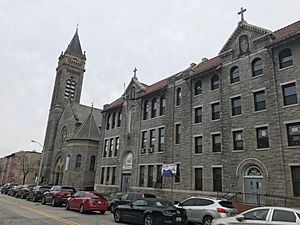St. Francis Xavier Church (Baltimore) facts for kids
Quick facts for kids St. Francis Xavier Church |
|
|---|---|
 |
|
| Lua error in Module:Location_map at line 420: attempt to index field 'wikibase' (a nil value). | |
| Location | 1501 E. Oliver Street, Baltimore, Maryland |
| Country | United States |
| Denomination | Catholic |
| Religious institute | Spiritans |
| History | |
| Founded | 1863 |
| Founder(s) | Black San Domingo refugees and the Sulpician Fathers |
| Dedication | Francis Xavier |
| Dedicated | February 21, 1864 |
| Architecture | |
| Functional status | Active |
| Heritage designation | For African-American Catholics |
| Architectural type | Church |
St. Francis Xavier Church in Baltimore, Maryland, is a very special place for Black Catholics. Many believe it was the first church in America created just for Black people. It officially started in 1863, but its history goes back even further, to the late 1700s.
Contents
A Church with a Long History
How It All Began
In 1791, several ships arrived in Fell's Point, Baltimore. They carried many Black Catholic refugees from a French colony called San Domingo (now Haiti). There were between 500 and 1,000 Black refugees, some free and some enslaved.
At the same time, a group of priests called the Sulpician Fathers had also come to America. They were escaping the French Revolution. These priests were connected to St. Mary's Seminary. The Haitian refugees, who also spoke French, began to meet in the seminary's basements.
Many of the free Black refugees were educated and wealthy. Because of this, the church became very popular with important African-American families in Baltimore.
Founding a School and Sisters
In 1828, one of the priests, Father James Joubert, worked with Mary Lange. Together, they started the Oblate Sisters of Providence. This was the first group of Catholic nuns of African descent in the United States. They also founded St. Frances Academy. This school became the first and oldest Black Catholic school in the country. When the Oblate Sisters moved in 1836, the church community moved with them.
A New Meeting Place
In the 1850s, another group of priests, the Jesuits, invited the church community to meet at St. Ignatius Church. They met in a basement chapel there. At this time, the group was known as Blessed Peter Claver.
Father Peter Louis Miller and Bishop Michael O'Connor were involved then. They later worked with William Augustine Williams, who was one of the first Black seminarians. They all helped the Black community at St. Ignatius/Peter Claver.
Becoming an Independent Parish
In 1863, the Jesuits, led by Father Anthony Ciampi, helped the Black congregation buy their own building. This building was officially opened the next year with its current name, St. Francis Xavier Church.
In 1871, the Mill Hill Fathers came from England. They were asked to serve African-Americans. That same year, they took charge of the parish. A few decades later, the Mill Hill operations in the U.S. became a new religious group. This group was called the Society of St. Joseph of the Sacred Heart, also known as the Josephites. They have been in charge of the parish ever since.
The church moved to a new location in 1932. Then, in 1968, it moved again to its current spot. This location is at the corner of Caroline and Oliver streets. The Oblate Sisters' school and convent are still nearby. The school now teaches both boys and girls.
New Ways to Worship
From the late 1960s to the 1990s, during the Black Catholic Movement, St. Francis Xavier Church became very important. It was the first church to allow and practice "shouting." This is a special kind of Black Christian liturgical dance. Black Catholics learned this practice from Black Protestantism.
New Leadership for the Church
In 2024, several Black Catholic churches in Baltimore closed. Because of this, the care of St. Francis Xavier Church changed hands. It moved from the Josephites to the Spiritans.
See also

